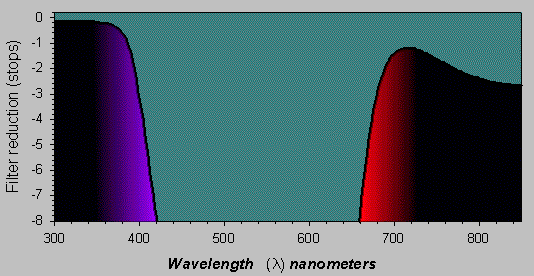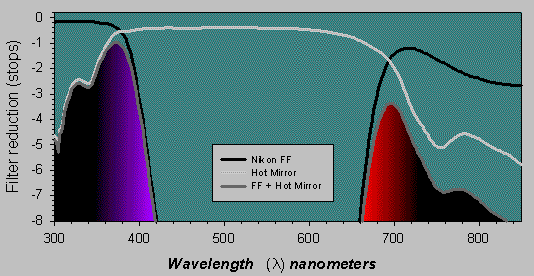Spectral Properties of Daylight and Filters Used in UV Photography
![]()
To understand how we can handle the challenge of UV reflective photography, we need to know about the spectral properties of the light that can strike the film to expose it. It is generally stated that some 50% of the irradiation incident to the earth surface is visible light with wavelengths from 400 nm (deep purple) to 700 nm (deep red). Of the remainder, most is IR (infrared) ranging from the near-IR band slightly beyond 700 nm to the thermal IR range at several micrometers wavelength. Just 10% or even less of the whole range of irradiation coming to earth is ultraviolet (UV). The UV range falls into three subranges; UV-A spanning the range 320-400 nm, UV-B going from 320 to 280 nm and UV-C below 280 nm. The energy content and thus potential harmfulness of the UV radiation increases rapidly when the wavelength decreases, so UV-B is much more hazardous to living beings than UV-A. Also, the effect upon film is stronger. However, this is counteracted by glass lenses that transmits very little radiation below ~ 370 nm. See Fig.1 for a demonstration of the difference in transmittance for an all-glass lens and a quartz-fluorite design.
|
Fig. 1. Light transmittance through a quartz-fluorite lens (UV-Nikkor 105 mm) and an ordinary glass lens with single-layer coating (Oscilloscope-Nikkor 55 mm).Note that the ordinary lens transmits very little light below some 370 nm. Data from actual measurements using a Li-1800 spectroradiometer. The deviation in transmittance forthe UV-Nikkor at ~300 nm is due to sensor inaccuracy. Multi-coated optics would passeven less light in the UV range than did the Oscilloscope-Nikkor. |
|
Fig. 2. Spectral distribution of incident irradiance at Oslo, Norway, June 1999. Measurements taken under clear blue skies and slightly hazy sun. |
An actual spectral reading of the incident irradiance is shown in Fig.2. These measurements were obtained using a Licor-1800 spectroradiometer with 2 nm resolution from 300 nm (UV-B) to 850 nm (near-IR). To make the plot more comprehensible to the photographic community, I recalculated the data as stops of reduction from the incident radiation within each spectral band. Baseline is the average spectral intensity of the visible range. So, we learn from this chart that visible light is distributed within ± 0.5 stop from the average intensity value in this band. Because the readings were taken under quite blue skies, the bluish colours prevail as we would indeed expect. To make a neutral exposure under this light regime, i.e. without any colour casts, we might apply a warming filter such as 81A and 81B.
The charts further indicates near-IR levels are substantial, as expected, but this would not influence most films because their spectral sensitivity rapidly declines above some 650 nm (deep red). Below the visible range, long-wave UV is present at -1 stops compared to visible light. From some 330 nm the UV levels drop sharply to be at the detection limit at 300 nm. Taken by itself, the UV range is well suitable to exposing film material. However, we must remember that modern films tend to incorporate UV screens to reduce the amount of UV that actually exposes the film dyes to negligible levels. Besides, multi-coated optics pass little UV themselves so the sum of UV being able to give an image on the film is very low indeed.
To enable us to record a UV image at all, other radiation bands must be screened off. This is accomplished by inserting a "true" UV filter into the optical path. Being visually opaque these frequently are designated "black" filters. Most are based upon silver metal deposits in gelatine which is enclosed by glass. Thus, these filters are quite thick and their thickness itself impacts the focusing of the lens shifting the focus to a closer distance than that of the non-filtered lens. Most lenses need a focus correction anyway when focused within the UV range. To a good approximation, this correction coincides with the IR mark on the lens barrel. Chromatic correction of the lens, with the exception of quartz-based special designs, is generally poor in UV and there will be a markedly softening of the image. This softness is enhanced by the diffuse nature of the UV light field.
Several brands of UV bandpass ("black") filters exist. Kodak Wratten 18A is perhaps the most well-known of these, while alternative filters are offered by Hoya (U-360) and Schott (UG-1, UG-11). Common to these filters is a low transmittance of UV below 320 nm, i.e. in the UV-B range. Nikon delivers a proprietary filter designated "FF" with their UV-Nikkor 105 mm f/4.5 lens. Since I own the UV-Nikkor, it's only natural that I also use the FF filter with it. There is no need to refocus the UV-Nikkor because its UV focus coincides perfectly with the visual focus. The FF filter is mounted on a hinged gel-type filter holder to make it easy to swing out of the optical path for focusing. I simply focus, secure the focus by tightening a focus-locking screw on the UV-Nikkor and swing the FF filter into place. I shoot with my Nikon bodies using normal TTL metering on all of them. This works with F3, F4, and F5 although only my F4 meters without a correction factor. The others need different factors, +1 for F3 and -1 for F5. A well-exposed UV image typically looks quite dark to us, because much material in Nature reflects little UV. The outer parts of flower petals by contrast reflect UV to a large extent, to make floral parts stand out clearly on a UV image. Examples of this are found here.
All UV bandpass filters exhibit a small side-lobe of radiative transmission towards the near-IR range. The exact position and extent of this side-lobe differ between the filters. I measured the transmission through my FF filter and the results are depicted in Fig.3 (upper panel). Evidently the Nikon FF filter is completely transparent to UV, in fact, within the UV-B region it transmits much better than the Kodak Wratten 18A. However this is accomplished by the Nikon filter being less dense within the red spectral band than the Kodak filter. This partly explains why my UV colour images exhibit vivid details in red.
It's possible to reduce the side-lobe in near-IR by combining a UV bandpass filter with a dichroic ("hot mirror") filter. I recently tested the Tiffen Hot Mirror in conjunction with the FF, and the results are shown in Fig.3 (lower panel). In principle this setup works, but unfortunately some UV transmittance is lost. I'm still testing the visual rendition attainable by using this setup, and shall report the results as soon as they become available.
 |
 |
Figure
3. |
| To Top | Far Side | Gallery | *UV | IR | Lenses | Links | Personal | Professional | Reviews | Start | |
Last Update 1 October, 2002 |